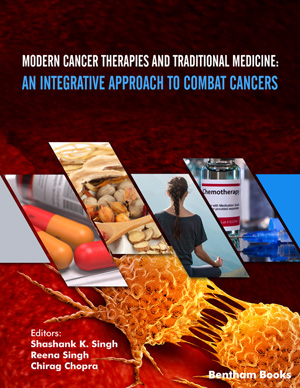
摘要
背景:MET受体酪氨酸激酶的异常表达是致癌决定因素和癌症治疗的药物靶点。目前,针对 MET 的基于抗体的生物治疗药物正在进行临床试验。 目的:在这里,我们报告了用于靶向癌症治疗的新型抗 MET 抗体-药物偶联物 PCMC1D3-duocarmycin SA (PCMC1D3-DCM) 的临床前和治疗评估。 方法:通过杂交瘤技术产生的单克隆抗体 PCMC1D3 (IgG1a/κ) 对 MET 细胞外结构域之一具有特异性,基于其对人 MET 的高特异性和 1.60 nM 的结合亲和力进行选择。 PCMC1D3 通过可切割的缬氨酸-瓜氨酸二肽接头与 DCM 偶联,形成药物与抗体比率为 3.6:1 的抗体-药物偶联物。体外 PCMC1D3-DCM 快速诱导 MET 内化,内化效力范围为 6.5 至 17.2 小时,具体取决于单个细胞系。 结果:使用不同类型癌细胞系的研究表明,PCMC1D3-DCM 会破坏细胞周期,降低细胞活力,并在治疗开始后 96 小时内导致大量细胞死亡。计算出的细胞活力降低的 IC50 值为 1.5 至 15.3 nM。小鼠异种移植肿瘤模型的结果表明,以 10 mg/kg 体重的单剂量注射 PCMC1D3-DCM 可有效延迟异种移植肿瘤的生长长达两周,而没有肿瘤再生的迹象。计算的肿瘤抑制浓度(平衡肿瘤生长和抑制所需的最小剂量)约为 2 mg/kg 体重。总之,PCMC1D3-DCM 在异种移植模型中可有效靶向抑制肿瘤生长。 结论:该工作为未来开发用于MET靶向癌症治疗的人源化PCMC1D3-DCM奠定了基础。
关键词: MET受体酪氨酸激酶、小鼠单克隆抗体、抗体-药物偶联物、多卡霉素、药物递送、体外细胞毒性、肿瘤异种移植模型、疗效。
图形摘要
[http://dx.doi.org/10.1038/s41568-018-0002-y] [PMID: 29674709]
[http://dx.doi.org/10.1038/nrc3545] [PMID: 23792360]
[http://dx.doi.org/10.1038/318385a0] [PMID: 4069211]
[http://dx.doi.org/10.1038/s41571-020-0377-z] [PMID: 32514147]
[http://dx.doi.org/10.1038/s41388-020-1193-8] [PMID: 32034310]
[http://dx.doi.org/10.1080/13543784.2020.1699532] [PMID: 31783719]
[http://dx.doi.org/10.2174/1568026619666190712205353] [PMID: 31526339]
[http://dx.doi.org/10.1016/j.bbcan.2020.188425] [PMID: 32961258]
[http://dx.doi.org/10.1016/j.drudis.2020.11.002] [PMID: 33171292]
[http://dx.doi.org/10.1186/s12885-016-2138-z] [PMID: 26879245]
[http://dx.doi.org/10.1002/1878-0261.12600] [PMID: 31736230]
[http://dx.doi.org/10.1038/s41401-018-0198-0] [PMID: 30643210]
[http://dx.doi.org/10.1021/acsomega.0c03102] [PMID: 33073104]
[http://dx.doi.org/10.1158/1078-0432.CCR-16-1568] [PMID: 27573171]
[http://dx.doi.org/10.1158/0008-5472.CAN-15-2833] [PMID: 27216193]
[http://dx.doi.org/10.1158/1535-7163.MCT-13-0628] [PMID: 24132142]
[http://dx.doi.org/10.1073/pnas.1819085116] [PMID: 30898885]
[http://dx.doi.org/10.1074/jbc.M116.753491] [PMID: 27694443]
[http://dx.doi.org/10.1158/1541-7786.MCR-19-0582] [PMID: 31659006]
[http://dx.doi.org/10.4161/cbt.5.9.3073] [PMID: 16880737]
[http://dx.doi.org/10.4143/crt.2019.726] [PMID: 32324988]
[http://dx.doi.org/10.1158/1078-0432.CCR-14-0898] [PMID: 25294907]
[http://dx.doi.org/10.1021/acs.molpharmaceut.8b00298] [PMID: 29944378]
[http://dx.doi.org/10.1186/s40425-019-0732-8] [PMID: 31519211]
[http://dx.doi.org/10.1186/s40425-019-0525-0]
[http://dx.doi.org/10.1158/1535-7163.MCT-18-0252] [PMID: 30275241]
[http://dx.doi.org/10.1016/j.ceb.2003.10.009] [PMID: 14644197]
[http://dx.doi.org/10.2174/1871520615666141216144116] [PMID: 25511515]
[http://dx.doi.org/10.1016/j.drudis.2020.11.020] [PMID: 33232841]
[PMID: 8443816]
[http://dx.doi.org/10.1111/j.1349-7006.1995.tb02997.x] [PMID: 7737904]
[http://dx.doi.org/10.1158/1535-7163.MCT-14-0040-T] [PMID: 25189543]
[http://dx.doi.org/10.1158/1535-7163.MCT-20-0116] [PMID: 32967924]
[http://dx.doi.org/10.1021/acs.bioconjchem.9b00133] [PMID: 30966735]
[http://dx.doi.org/10.1177/17588359211006957] [PMID: 33868463]
[http://dx.doi.org/10.1038/bjc.2011.298] [PMID: 21847116]
[http://dx.doi.org/10.1371/journal.pone.0078398] [PMID: 24223799]
[http://dx.doi.org/10.1038/sj.neo.7900080] [PMID: 10935508]
[http://dx.doi.org/10.1158/0008-5472.CAN-08-4889] [PMID: 19808973]
[http://dx.doi.org/10.1016/j.molonc.2014.08.015] [PMID: 25248999]
[http://dx.doi.org/10.1186/s12885-016-2058-y] [PMID: 26801760]
[http://dx.doi.org/10.1016/j.bbrc.2009.09.019] [PMID: 19744467]
[http://dx.doi.org/10.1093/carcin/bgr086] [PMID: 21565828]
[http://dx.doi.org/10.1371/journal.pone.0040420] [PMID: 22815748]
























